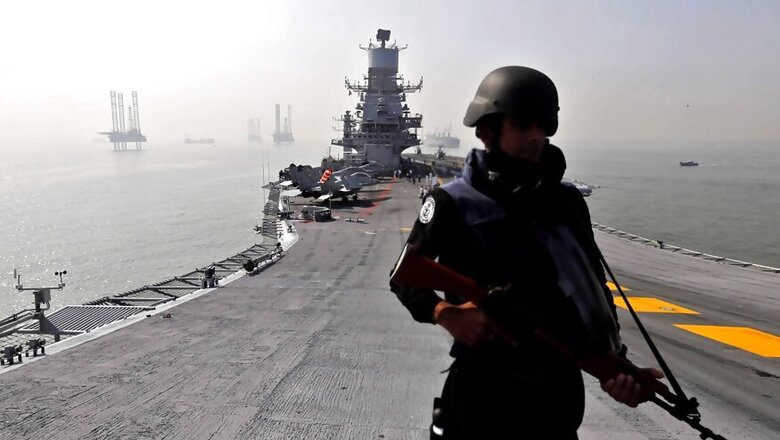
views
New Delhi: India has the sixth highest defence budget and the second largest standing armed force in the world. Yet, the nation is labouring to replace ageing equipment and modernise its forces.
Despite a modernisation push by the Ministry of Defence (MoD), the growth rate of the defence budget has fallen. Even its share of the Central Government Expenditure has come down.
In 2016-17, the Government allocated Rs 2,49,099 crore to the MoD, a rise of 9.95% from the 2015-16 Defence Budget. This was 17.24% of the Central Government’s Capital Expenditure. In 2017-18, the Finance Minister allocated Rs 2,62,389 crore to the ministry. Compared to the previous financial year, this was a rise of only 5.55% and the share in the government’s capital expenditure shrunk to 16.76%.
But even more worrying, for a nation that is upgrading its military, was that while there was an overall rise in the defence budget, the modernisation budget of the Armed Forces actually ended up less than the previous year. In 2015-16, the modernisation budget of the Armed Forces was Rs 70,414 crore, which shrunk by 0.9% to Rs 69,783 crore. Only the Air Force modernisation budget saw a jump of 12.1%. The Navy modernisation budget fell by 12.1% and the Army modernization budget by 6.4%.
What’s more, only 12% or Rs 8,590 crore of the total Defence modernisation budget was for ‘New Schemes’, while 88% or Rs 61,410 crore was for “Committed liabilities”. This will have to change in 2018, particularly in the case of the Indian Air Force (IAF).
In the IAF modernisation budget, only around 17% or Rs 4,685 crore of the total Rs 27,556 crore modernisation budget was allocated for ‘New Schemes’. Whether this amount goes up or down will give a clearer indication of whether or not the government will move faster on potential aircraft deals to replace the IAF’s ageing fleet of fighter jets.
The Indian Air Force (IAF) has been largely dependent on MiG 21s and MiG 27s. These Soviet-era aircrafts are fast becoming obsolete and reports of malfunction are not uncommon. So bad is the condition of the MiG that it has earned the ominous epithet “Flying Coffin” and “Widow-maker”. There have been at least 10 accidents involving the MiG over the last five years.
The entire fleet will have to be replaced with modern aircraft and fast. A deal is in the works and India is all set to buy 126 such aircraft. What needs to be decided now is which fighter jet India will buy. The choice is between two good aircrafts – The F-16 Block 70 produced by American firm Lockheed Martin and the JAS 39 Gripen E by Swedish company Saab. The deal, whoever wins it, will be inked under Prime Minister Modi’s ‘Make in India’ doctrine. The aircraft will be manufactured on Indian soil. For the Make in India push, Lockheed Martin has tied up with Tata while Saab recently announced a partnership with the Adani Group.
But India’s air prowess is on the descent. According to figures tabled by the Ministry of Defence in the Lok Sabha during the Winter Session of Parliament last month, India will have fewer squadrons by 2025 than it currently possesses. To make matters worse, numbers reveal that the Modi government would not have added any new squadrons to the IAF by the end of its first term in power by 2019.
During the 2014 Lok Sabha elections, the Bharatiya Janata Party (BJP) lashed out at the ruling UPA by expressing “concern” at the pace at which squadrons were being added to the Indian Air Force (IAF). The BJP in its manifesto called it an “indication of surrendering of India’s interests” and called for a complete overhaul of the system. But figures tabled in the Lok Sabha by the Ministry of Defence reveal that there would be no net increase in the number of squadrons added by the NDA government in its five-year tenure. In fact, by 2025, the IAF may end up having fewer squadrons than it currently possesses.
The Indian Air Force currently possesses 32 squadrons but three squadrons of MiG-21 aircraft will be phased out by 2020. By 2019, the government plans the introduction of two squadrons of Su-30MKIs. Two squadrons of the Jaguar are also set to retire during this period. Between now and 2025, the government plans to procure two additional squadrons of the Su-30MKI, two squadrons of the Rafale and six Squadrons of the Tejas, a single-engine fighter. So while India will see 12 squadrons retire by 2024, the country will have added only 10 to offset those losses by 2025.
Air Chief BS Dhanoa’s assessment that India plans to have a 42-Squadron Air Force by 2032 seems tough to achieve given the current pace of procurement by the Indian government. But one way in which the government may just be able to pull off this feat is if it manages to ink deals for single-engine fighter aircrafts with haste.
Air Defence expert Air Vice Marshal (retired) Manmohan Bahadur said, “It may seem difficult at this stage to have 42-squadrons by 2032 but I think we can pull it off. It all depends on the pace at which the Tejas is manufactured and whether India will be able to procure single-engine fighter jets on time.”
Similarly, as India gets set to play a more active role in the Indian Ocean Region (IOR) and the Indo-Pacific, with an aggressive China expanding its ‘String of Pearls’, a powerful, new-age, well-equipped navy is essential to not only guard its over 7,500 km coastline but also secure India’s interest in the IOR.
While the Indian Navy received some relief with the commissioning of INS Kalvari, it still has to make do with a fleet of 13, mostly ageing, submarines. Navy Chief Admiral Sunil Lanba had said earlier that India planned to have a fleet of 22 submarines by 2020-21. With just three years and eight more submarines left to be acquired, the Navy will hope its modernisation budget for ‘New Schemes’ is raised as compared to last year.
The Army, too, needs new equipment and fast. The Army is in urgent need of reconnaissance helicopters and Army Chief Bipin Rawat, at the Army’s annual press conference this month, said the army was looking at 2019 to replace the ageing fleet of Chetak helicopters. Speaking on the acquisition of new assault rifles for the Army, the chief struck a realistic note. “The Hi-Tech assault rifles with night-firing capability cannot be given to the entire army because they are expensive. So they will be given to infantry soldiers at the border, who face the adversary first,” he said.
2018 will also be the year the Indian Army will address the shortfall of newer Bullet-Proof Jackets (BPJs), particularly with troops serving at the Line of Control in Jammu and Kashmir. Rawat said, “Our BPJs are ineffective against some of the weapons used by insurgents so we had to issue a new GSQR for upgraded bullet-proof jackets. The testing and procurement process has begun. So we will have jackets coming in batches of 20,000-25,000 every quarter and our requirement will be met by 2019. We even had to send some BPJs and ballistic helmets to the UN peacekeeping mission. The old BPJs are not very effective against steel-core bullets of the AK-47 used by terrorists.”



















Comments
0 comment